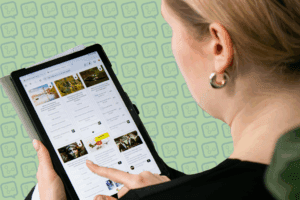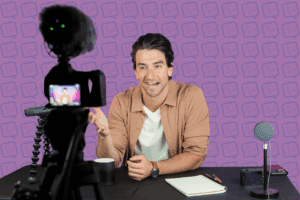Ease the Burden of Content Marketing With Influencer Marketing

Do you know how long it took me to come up with the intro to this article?
I had developed its concept, did extensive research, refined my angle and argued my point.
That alone took hours.
After all of this, I still needed an intro. I still needed a hook to get you to keep reading. My brain was fried, my creativity almost exhausted. Yet I had to push through. I had to finish. I had to peak your interest.
Am I trying to win your sympathy? Maybe. But my main point: content marketing can be laborious work.
Seriously, it’s hard. Not only did I commit a lot of my resources to developing this article, I also had to figure out who I wanted to reach, how I wanted to sound and where to share it.
There are so many steps to an effective content strategy it’s no wonder myself and brands are struggling to consistently produce good content.
It’s not from lack of effort. There’s been a 350% increase in content marketing jobs since 2011. In 2016, brands spent 32% of their marketing budget on content marketing efforts.
More and more resources are being allocated to this discipline because of the intensive process required to create good content. For most brands, this usually involves:
- Identifying a target audience
- Developing the right voice
- Creating consistent, creative content
- Maximizing visibility through distribution channels
See, a lot of work. Wouldn’t it be nice if there was a shortcut?
Well, I think there is one. My content marketing hack for 2017: influencer marketing.
Influencer marketing can dramatically reduce the burden content marketing places on a brand. Too often, brands only think about influencers as a distribution strategy. They speak to the audience we want to reach, so they can better push our content to them.
While this is true, influencers can be so much more. They have a unique voice and a highly engaged, fanatical target audience. They consistently develop relevant and creative content to speak to this audience.
Influencers are highly skilled content marketers. Working with them can supercharge a brand’s content strategy and simultaneous reduce the burden.
They Provide Terrific Insight Into a Target Audience
A great content marketing strategy starts with identifying a target audience. If you don’t know who you are talking to, there is no strategy. Quicksprout has published an in-depth guide to building a brand in which the second chapter gives terrific insight into identifying a target audience. In this guide they identify three people that will fit into your target audience:
- The Person That Will Pay You
- The Person That Influences The Person That Pays You
- Your Supporter
Quicksprout’s “The Person That Will Pay You” is the basis of all target audiences: the customer persona. This needs to be developed as the basis for any content marketing campaign (and any business, brand or even idea). There are many options when developing a customer persona, but the majority of persona templates include: age, gender, job details and interests.
It’s the “interests” section that provides the meat of most personas. Quicksprout identifies these as “The Person That Influences the Person That Pays You.” In traditional persona building, the “person” that influences is usually a publication. For example, back in my youth in 2004 I might have fallen into the following category in a brand’s customer persona:
20 year old male, works at the mall while attending college, sports fan that reads ESPN.com.
It’s over a decade later and I never read ESPN.com anymore, so I can’t imagine today’s 20 year olds are. Their persona might read more like:
20 year old male, works at the mall while attending college, sports fans who browses Reddit.com/r/NBA and follows James Harden on Instagram.
Are those personas really that different? In the end, it’s just a 20 year-old who is interested in sports.
In the world of fragmented media, yes. The audience for James Harden on Instagram is going to have different interests than the audience for Tom Brady.
When my company, InfluenceLogic, was developing an influencer marketing campaign for UGG we matched the brand’s customer persona to particular influencers that represented that persona.
We knew one segment of UGG’s potential customers were females in their 20s that lived in bigger cities, were tech savvy and had disposable income. From there, we started to identify influencers that spoke to this demographic: mid 20s to mid 30s fashion and lifestyle vloggers. We went straight for the person that was influencing them – completely bypassing the traditional publication.
Identification is vital to any influencer marketing campaign, but the process can also help you think holistically about who your target audience is. James Harden is an actual person. What he wears or may say will give me terrific insight into what that 20 year old that is interested in. Back in my youth, a brand couldn’t glean this insight from ESPN.com. They would have to broad match interests based on the current demographics of sports fans.
Summary: Start by broad matching your customer persona to an interest, then identify influencers that are trending for that interest. The influencers themselves will give you even more insight into your persona.
They already have the right voice – They wouldn’t have the following if they didn’t.
Once we find a target audience, we have to figure how to speak to them. For every brand that has nailed their voice, there are cringeworthy examples of brands attempting to “fit in.”
For example, remember this tweet from the campaign trail:
How does your student loan debt make you feel?
Tell us in 3 emojis or less.— Hillary Clinton (@HillaryClinton) August 12, 2015
Hillary Clinton’s campaign had some terrific digital marketing efforts, but this one really missed the mark. In hindsight, it’s obvious this was going to backfire. In the moment, it’s far harder to make that determination. Emojis are hot with millennials, millennials worry about student loan debt – what could go wrong?
The Nielsen Norman Group’s recent report The Impact of Tone of Voice on Users’ Brand Perception, they analyzed a variety of brand voices and ran various experiments on what performed best. They found:
Different tones of voice on a website have measurable impacts on users’ perceptions of a brand’s friendliness, trustworthiness, and desirability. Casual, conversational, and enthusiastic tones performed best.
The Clinton Campaign was clearly making an attempt at this casual and conversational tone to discuss student loan debt, but the tweet still missed the mark. It’s “fails” such as this that cause many brands to get conservative with their voice. They take less risks and as a result they often produce less interesting content.
The biggest, unrealized benefit of influencer marketing: it’s a vehicle to tap into the voice of your target audience.
An influencer’s connection with their fans originates from their voice, they wouldn’t have gained a following if it didn’t. We don’t have to agonize over how to craft our messages, we can vet the influencer to be sure their voice fits in with ours and let them deliver our message the best way they see fit.
Do you remember in the Dark Knight Rises where Bane encounters Batman and lectures him about darkness?
“Ah you think darkness is your ally? You merely adopted the dark. I was born in it, molded by it. I didn’t see the light until I was already a man, by then it was nothing to me but blinding!”
This is exactly how I view an influencer’s voice. Brands attempt to adopt it, but influencers were born into it – molded by it. Let their voice be your voice.
Summary: Identify influencers who’s voice meets your brand standards and let them deliver the message – they will be right more often than your research will be.
They’re already developing creative, valuable and shareable content
Developing consistent and creative content is vital to the success of a content marketing strategy. The time and effort that goes into this creative is daunting. Smartblogger published an exhaustive list to creating epic content and while it serves as a fantastic guide it is also so complex I fear it might deter just as many people as it inspires. A quick rundown of their list (I really suggest you read the whole article):
- Conduct obsessive amounts of research. If you are an expert in your field, you’ll be able to competently talk about your topic.
- Experiment and provide detailed data to your audience so they learn through your experiences.
- Position yourself as a contrarian to the conventional thought.
- Get into the head of your audience, identify what they are talking about and what motivates them to take action.
These are absolutely the steps that need to taken to produce great content – but the time commitment is incredulous. This process is the main reason why content creation is such a burden on marketing departments. This high barrier to entry disqualifies a lot of smaller companies from consistently producing fantastic content. It’s also why it can cost large sums of money to contract out to content marketing agencies.
The brightside to the costs of creating great content: if you can do it consistently, there’s a big advantage to be gained over your competitors. As Ed McCabe said:
Imagination is one of the last remaining legal means you have to gain an unfair advantage over your competition.
Influencers are overflowing with imagination. Not only are their minds filled with creative content ideas that speak directly to a target audience, but they have the tools and resources to produce this content in a manner that would normally cost thousands of dollars or hours of time.
One of the partnerships InfluenceLogic facilitated for UGG was with Nil Sani, a rising star on YouTube. The content she produced was incredible:
Ugg’s goal was to position themselves as a “cool” brand and this video was a great asset towards accomplishing this goal. It might have cost UGG $15,000 to produce a spot similar to this with a traditional advertising agency, but by unlocking the passion of an imaginative influencer with the right target audience they did it for far less. Nil handled everything: the creative, filming and production. She knows exactly how to talk to her audience, so UGG didn’t have to pay an agency to spend hours researching how her target audience talks.
Summary: Influencers are already producing creative content. Give them guidelines and let them do the heavy creative lifting. Think of them as members of your content marketing team.
They Are Distribution Machines
Allow me to let Lee Odden, CEO of TopRank Marketing, preach for a second:
Great content isn’t great until it’s discovered, consumed and shared.
Distribution of content can be as exhausting as the creation process. There are both long-term and short-term strategies that are currently in use for brands that don’t have large audiences. A few examples:
Long Term
- SEO
- Build an email list
- Build a following on Facebook/Twitter/LinkedIn
- Guest blogging
Short Term
- PPC
- True View Ads
- Native advertising
- Sponsored content
Long term strategies won’t produce much in the interim, and the short term strategies might fail to create a lasting audience or drive the desired action.
As mentioned above, influencer marketing is primarily thought of as a distribution channel. Most clients I’ve spoken to seem to think of it the same way they think of promoting a Facebook post: find the right target audience to amplify their content.
A negative opinion of influencer marketing can exist because people only recognize the distribution channel and are uncomfortable with the lack of control they may have over content or the less-streamlined process of negotiating with an influencer as opposed to a self-serve ad platform.
These are only valid points if we overlook the additional benefits of working with an influencer. Paid advertising might be a cheaper option if you are only measuring specific metrics, but you’re getting so much more from an influencer. You’re buying their voice, their content creation ability and their bond they’ve developed with an audience.
A self-service ad platform provides none of this.
Summary: Influencers get your message in front of their target audience. Due to the trust the influencer has with this audience, they are far more receptive to the message than through traditional advertising.
In 2017, the burden of content marketing is going to grow even more. Influencer marketing is a terrific solution to scaling your content strategy without taxing your resources.





